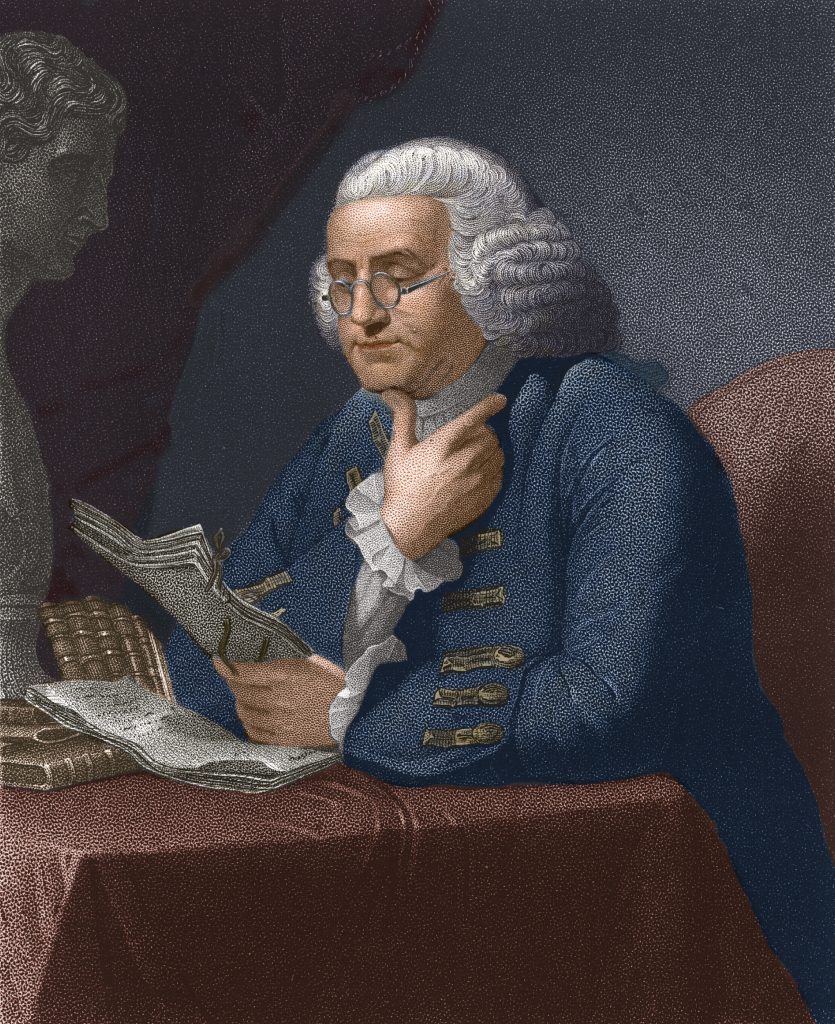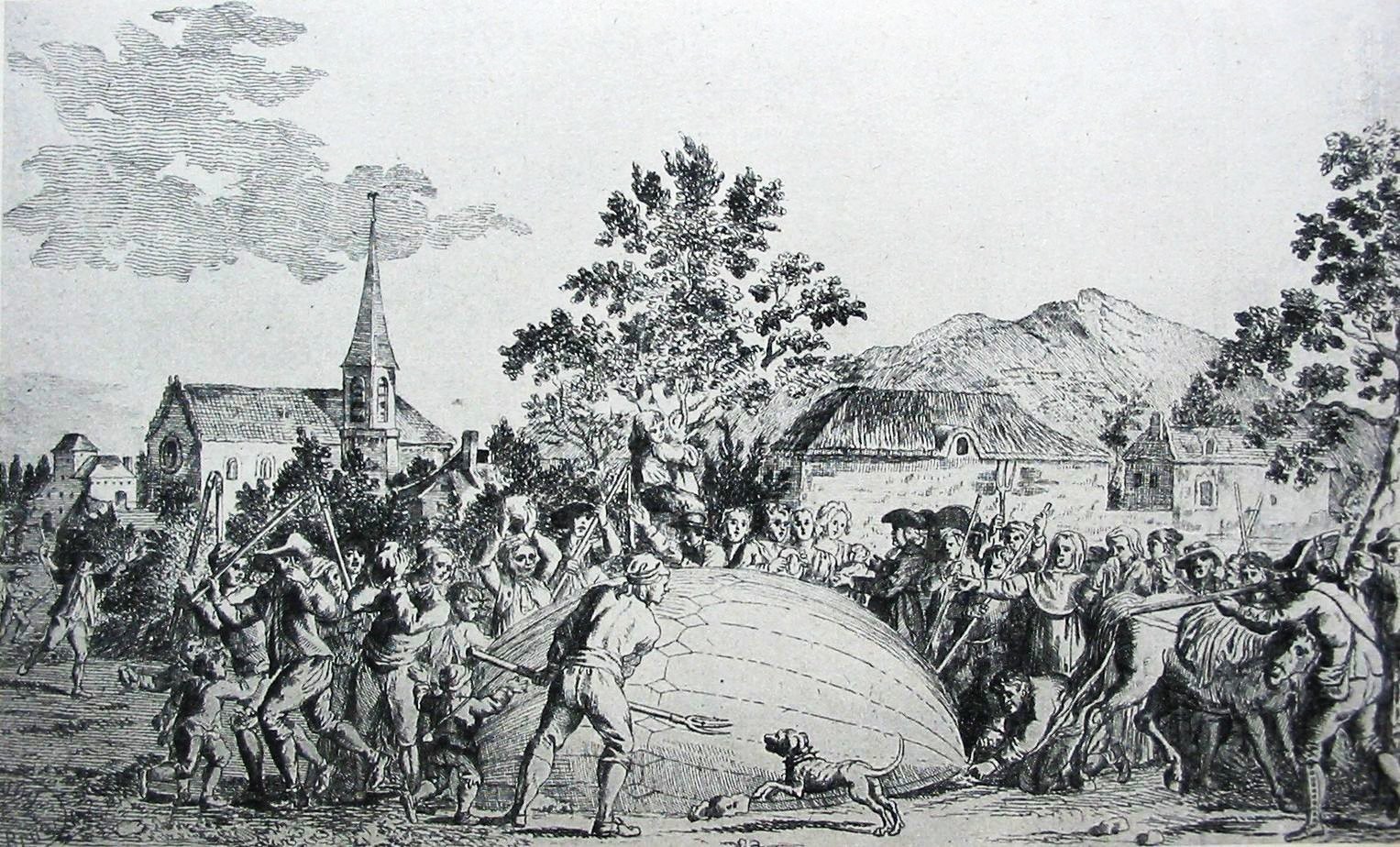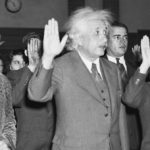On this day, August 27, in 1783, Benjamin Franklin was in Paris, serving as Ambassador of the United States to France. It was a role that Franklin relished. In France he was in effect both America’s first ambassador and First Scientist, the fame of his experiment with a kite and electricity, among other endeavors, having preceded him. It seemed as if no door in Paris was closed to him. Given his combination of curiosity and congeniality, he took full advantage of the opportunity to be out and about.

That late summer afternoon found Franklin at the Champs de Mars, the park where Gustave Eiffel would construct his famous tower a century later. [1] In Franklin’s time it was a field connecting France’s Military School with the River Seine. It had rained that morning, but the afternoon was dry. As the clock struck five, Franklin heard the loud firing of two cannons. He was hardly alone in hearing them. More than 50,000 Parisians had gathered in and around the Champs de Mars, all for the same purpose – to see the ascent of the newest rage in France: a balloon.
Earlier that morning, a man named Jacques Alexandre César Charles had brought his creation to the field to inflate it. It was only 12 feet wide, and it weighed a mere 25 pounds. It couldn’t carry a person aloft. In fact, it couldn’t carry anything at all. But it was cutting-edge technology and a sight to behold. It followed quickly on the heels of a balloon designed by the Montgolfier brothers. Their success had inspired local Parisians to commission Charles to create his own balloon and provide a demonstration for the capital.

As the day progressed, Charles lit fire to oil on iron filings – heating “oil of vitriol”, or sulfuric acid – to fill the balloon with hydrogen while holding it to the ground with a cord. The balloon glistened as the late afternoon sun broke through the clouds, the earlier rain having wet its silk canvas. As the cannons fired, the cord was cut. The 50,000 spectators saw something they hadn’t witnessed before, a man-made creation rising steadily into the air. Like so many new technologies that have since followed, at first viewing it must have seemed a bit like magic. Franklin observed that the balloon didn’t just float, “it moved the resisting air out of the way.” With little wind, the huge orb slowly drifted towards the horizon, looking “as small as an orange” when it pierced the clouds.
And then the balloon was gone. The crowd dispersed. The departing spectators gossiped excitedly about the future of such an invention. Franklin couldn’t resist sharing in the speculation.
[2] The inventor imagined that a horse could be suspended from a balloon so that the weight of its feet on land would be as little as eight or ten pounds, enabling it to travel across a country “as fast as the wind.” Or perhaps, he thought, people would keep higher altitude balloons anchored nearby, and with the help of a pulley, store meat and ice inside them, chilled by the cold air.
The 50,000 spectators saw something they hadn’t witnessed before, a man-made creation rising steadily into the air.

Not everyone shared in this enthusiasm. French farmers living in the countryside where the balloon descended that evening reacted with fear and horror. Assuming an animal was inside, they attacked the balloon with stones and knives, badly damaging it. Scientists in England were more level-headed but nonetheless skeptical. As Franklin argued in his correspondence with the head of the Royal Society in London, the English were too practical, or “bashful” as Franklin put it, to experiment with balloons.[3] Franklin urged them to embrace the new technology without knowing where it would lead or what practical benefits it would produce. Innovation required that one be prepared to be laughed at. The best approach, he argued, was to be the first to laugh at oneself.
Later that fall, Franklin witnessed more balloons take flight. The technology progressed quickly. By October a balloon launched with a miniature version of Noah’s ark, containing a sheep, a duck, and a rooster. A month later men took to the air for the first time. In December, they repeated the experiment from the center of Paris in front of a crowd, which like during a modern-day rocket launch, gazed upwards.
While the public was captivated by ballooning, the debate on its practical benefits continued. These arguments were captured in a brief exchange after one such launch when a spectator asked what good a balloon was. Franklin quickly countered, “What good is a newborn baby?” [4] After all, the technology was in its infancy and its value and potential were yet to be determined.

Franklin’s retort captured in a few words a multitude of implications about innovation. At a time when there is so much discussion and speculation about the future of technology and its likely impacts, this day in 1783 provides a powerful dose of humility.
the future of technology is so difficult to predict. Many inventions seem clear in hindsight. But the horizon on most days is obscured by fog.
Benjamin Franklin may have been a leading scientist of his generation, but his early speculation on the potential uses for balloons was misguided. They were never used to help horses travel faster or keep meat cool. With the benefit of hindsight, balloons were not well-suited for either task. But more importantly, other inventions proved more useful in addressing human needs. Often the future adoption of one invention is likely to be impacted by others. This is one reason the future of technology is so difficult to predict. Many inventions seem clear in hindsight. But the horizon on most days is obscured by fog.
If precision is difficult in predicting direction, it is even more difficult when it comes to predicting a timeline for innovation. In the centuries since the first balloons, technologists have often been wrong when it comes to timing, typically overestimating how quickly technology will change in the short-run while underestimating change and its impacts in the long-run.
It’s worth recalling the dismay of the French in the countryside who witnessed the early balloon landing. While their worries of balloons containing creatures proved groundless, the very invention they feared helped usher in changes to transportation, including by air, which ultimately improved the lives of French farmers. French grapes found their way into French wine that made its way around the world, including to Franklin’s home in the United States. Wine eventually also made its way across the Atlantic in the reverse direction. Change was not universally positive. It almost never is.
Despite both uncertainty in prediction and mixture in societal impact, Franklin nonetheless had it right when he advised the British. The future typically belongs to those who ride a wave, even though they lack the ability to control it. They’re likely to be most successful over the long-run when they combine the courage of their convictions with the humility to recognize that much remains uncertain. Continued learning and adaptation is essential.
It’s interesting to see these fundamental insights from Franklin’s experience gain renewed attention in recent years. They’re reflected in the thinking and writing of academics such as Carol Dweck and Claude Steele, whose research has pointed to the importance of having a “growth mindset.” [5] As employees at Microsoft, we see the application of these insights first-hand in the cultural changes that Satya Nadella has led at our company. At the core of all this is a conviction that success in future technology markets will belong not to those who “know it all,” but to those committed to “learning it all.” If anything, Franklin was a very early adopter of this approach. After all, what better test of a growth mindset than a willingness to experiment and even be the first to laugh at oneself over the inevitable resulting failures?
In recent months, we’ve seen new research and writing that points to the importance of a learning culture across all business environments. Harvard professor Amy Edmondson’s recent article about “The Competitive Imperative of Learning” has a title that says it all. As she captures well, the need to encourage a learning culture is changing the role of leaders and the contributions of employees in companies around the world.
There’s another interesting aspect of Franklin’s experience that sheds insight on what it takes to develop a growth mindset, and it perhaps gets less attention than it deserves. The starting point for almost all learning is a willingness to recognize how much we still do not know. In other words, it helps to be humble.
What’s true for individuals and companies working on new technology is also true for technology policy issues for governments and societies more broadly. Technology’s benefits will not be distributed uniformly, and new problems will need to be addressed as they arise. But even here, one needs to recognize the limitations of future predictions. One needs to take care not to unleash unintended consequences, especially early in a new technology lifecycle.
Ultimately, there is only one thing that is definitively true about the future. It will become what we collectively make of it. A dose of humility can help us make it better.
Ultimately, there is only one thing that is definitively true about the future. It will become what we collectively make of it. A dose of humility can help us make it better.
Today in Technology is a series that highlights important technology developments from the past and discusses the insights they offer for the tech trends and issues of our own day.
[1] Letter from Benjamin Franklin to Sir Joseph Banks, August 30, 1783, in Abbott Lawrence Rotch, “Benjamin Franklin and the First Balloons,” Proceedings of the American Antiquarian Society (April 1907), p. 260. http://www.americanantiquarian.org/proceedings/44817240.pdf
[2] Ibid., 263.
[3] Letter from Benjamin Franklin to Sir Joseph Banks, November 21, 1783, in Ibid., 268.
[4] Walter Isaacson, Benjamin Franklin: An American Life (New York: Simon & Schuster, 2003), 423.
[5] See Carol S. Dweck, Growth Mindset: The New Psychology of Success (New York: Ballantine Books, 2006), and Claude M. Steele, Whistling Vivaldi: How Stereotypes Affect Us and What We Can Do (New York: W.W. Norton & Company, 2010).









